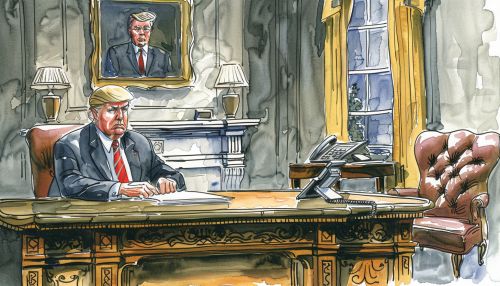Editorial cartoon
Editorial Cartoon
An editorial cartoon, also known as a political cartoon, is a form of visual commentary that offers a satirical or humorous perspective on current events, political issues, and social trends. These cartoons are typically found in newspapers, magazines, and online publications, and they use visual metaphors and caricatures to convey their messages. Editorial cartoons play a significant role in shaping public opinion and providing critical commentary on the actions of political figures and institutions.


History
The history of editorial cartoons dates back to the 18th century, with some of the earliest examples appearing in British publications. One of the most notable early cartoonists was James Gillray, whose works often targeted political figures and events of his time. Gillray's cartoons were known for their sharp wit and detailed caricatures, setting a standard for future cartoonists.
In the United States, editorial cartoons gained prominence during the 19th century, particularly during the American Civil War. Cartoonists like Thomas Nast became famous for their powerful imagery and ability to influence public opinion. Nast's cartoons were instrumental in shaping perceptions of political corruption and social issues, and he is often credited with creating the modern image of Santa Claus and the Republican Party's elephant symbol.
Throughout the 20th century, editorial cartoons continued to evolve, with notable figures such as Herblock (Herbert Block) and Bill Mauldin making significant contributions. Herblock's cartoons were known for their critique of McCarthyism and other political issues, while Mauldin's work focused on the experiences of soldiers during World War II.
Techniques and Styles
Editorial cartoonists employ a variety of techniques and styles to convey their messages. Some common elements include:
- **Caricature**: Exaggerating the physical features of public figures to create a recognizable and often humorous likeness.
- **Symbolism**: Using symbols to represent larger concepts or ideas. For example, a dove might symbolize peace, while a hawk represents war.
- **Irony and Satire**: Highlighting the absurdity or contradictions in a situation to criticize or mock it.
- **Visual Metaphors**: Using images to represent abstract ideas or complex issues. For example, a sinking ship might symbolize a failing political campaign.
Impact and Influence
Editorial cartoons have a significant impact on public discourse and can influence the way people perceive political events and figures. They often serve as a form of social commentary, providing a critical perspective on issues that might not be covered in traditional news articles. By distilling complex topics into a single image, editorial cartoons can make powerful statements that resonate with a wide audience.
In addition to their role in shaping public opinion, editorial cartoons have also been the subject of controversy and censorship. Cartoonists often push the boundaries of acceptable discourse, and their work can provoke strong reactions from both supporters and detractors. In some cases, cartoons have led to legal battles, public protests, and even violence.
Notable Editorial Cartoonists
Several editorial cartoonists have gained recognition for their contributions to the field. Some of the most notable include:
- **James Gillray**: An early British cartoonist known for his satirical depictions of political figures.
- **Thomas Nast**: An American cartoonist whose work helped expose political corruption and shape public opinion during the 19th century.
- **Herblock (Herbert Block)**: A 20th-century American cartoonist known for his critique of McCarthyism and other political issues.
- **Bill Mauldin**: An American cartoonist who focused on the experiences of soldiers during World War II.
- **Patrick Oliphant**: An Australian-born cartoonist whose work has been widely published in American newspapers and magazines.
Modern Editorial Cartoons
In the digital age, editorial cartoons have adapted to new media platforms. Many cartoonists now publish their work online, reaching a global audience through social media and digital publications. This shift has allowed for greater diversity in styles and perspectives, as cartoonists from around the world can share their work with a wider audience.
Despite the changes in how editorial cartoons are distributed, their core purpose remains the same: to provide a critical and often humorous perspective on current events and social issues. As long as there are political figures and institutions to critique, editorial cartoons will continue to play a vital role in public discourse.
